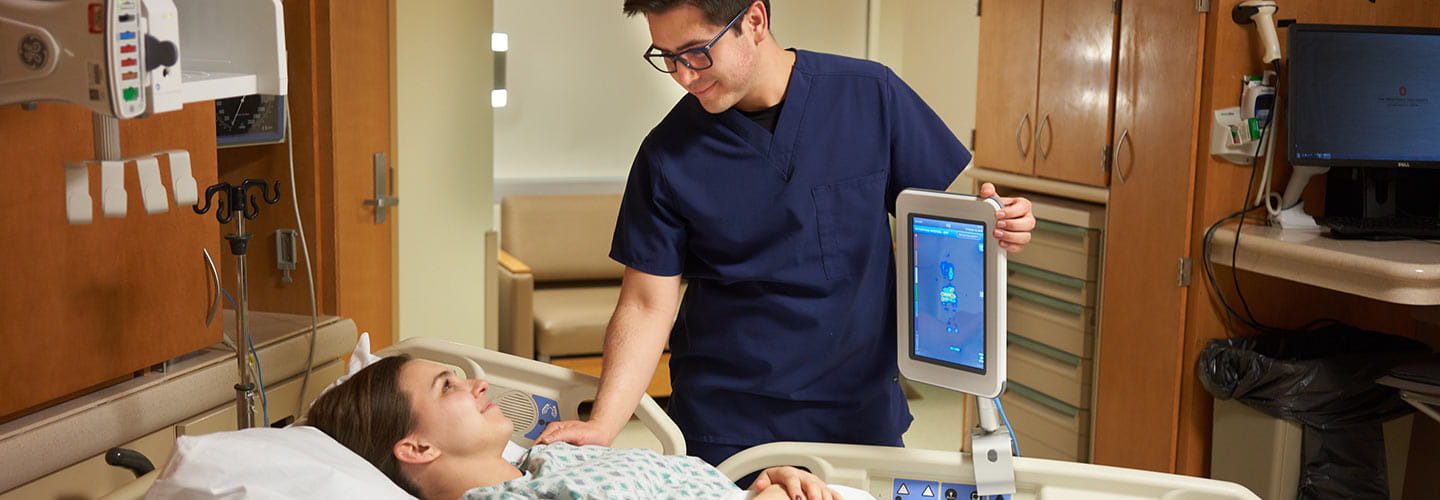Quality, evidence-based practice and patient outcomes
The nurses, support staff and other professionals in Health System Nursing Services are committed to improving health in Ohio and across the world through innovation in research, education and patient care.
The Health System Nursing Services team provides direction and resources to evaluate nursing practice patterns and patient outcomes, to communicate and disseminate best practices, and to support research initiatives that improve the quality of personalized care and the efficient utilization of resources for our patients. Nursing Quality, Nursing Evidence-based Practice and Standards, and Nursing Research are the specialty areas in the Health System Nursing Shared Services Department.

Nurses at The Ohio State University Wexner Medical Center utilize evidence-based practice to advance nursing practice and patient care through the integration of best available evidence. Evidence-based practice is an approach to problem-solving and decision-making in patient care and health care delivery that integrates:
- The best available evidence from research and credible non-research sources
- The clinician’s professional experience and expertise
- The patient’s personal preferences and values
Evidence-based practice is central to our goals of achieving the highest quality patient outcomes, attracting and retaining a workforce of excellent nursing professionals, and providing a workplace environment for nursing practice to thrive. It has been demonstrated in a variety of clinical studies that patients who receive health care based on the best available evidence experience more positive outcomes and less adverse events. Findings from recent research also indicate that when nurses are engaged in EBP, they experience greater professional autonomy and a higher degree of satisfaction with their practice.
Health System Nursing at Ohio State has structures and processes in place to support an environment of inquiry and innovation where nurses identify and examine tradition-based practices, investigate sources of best evidence, and implement and evaluate evidence-based practice changes that result in improved patient outcomes and excellence in nursing practice. These structures and processes include:
- Standards of practice councils and committees and interdisciplinary teams and task force groups responsible for reviewing current practice and best evidence and establishing practice standards
- Evaluation and synthesis tables incorporated into nursing policies and procedures
- Evidence-based practice mentors who are knowledgeable and skilled in the process of EBP and dedicated to assisting colleagues in integrating evidence into daily clinical practice
- A partnership with the health sciences library for the acquisition of best evidence sources, and
- Educational programming that fosters clinical inquiry and evidence-based practice skill development
Advanced Practice
In October 2010, the Robert Wood Johnson Foundation and the Institute of Medicine (IOM) jointly released The Future of Nursing: Leading Change, Advancing Health, calling it a blueprint for transforming the American health system by strengthening nursing care and better preparing nurses to help lead reform. Included within this call to nursing are Advanced Practice Nurses (APRNs), registered nurses educated at master’s or post-master’s level and in a specific role and patient population. They are prepared by education and certification to assess, diagnose and manage patient problems, order tests and prescribe medications. APRNs include nurse practitioners (NPs), clinical nurse specialists (CNSs), certified registered nurse anesthetists (CRNAs) and certified nurse-midwives (CNMs).
This blueprint by the IOM called for all nurses to operate at the “top of their license,” meaning practicing to the full extent of their education and training, instead of spending time doing something that could be effectively done by someone else. Within the changing health care landscape, it’s important that as a health system we maximize the limited hours and dollars we have – and spend them on the highest-skilled work each care team member can do. In that regard, care teams within the medical center are being examined to assure that the work being done is within the scope of practice of the practitioner doing the task.
Within the health system, NPs are part of a group called advanced practice providers (APPs). APPs also include physician assistants (PAs). Within our health system, all APPs report to the director of APPs, who reports to the chief nursing executive. The director has APP managers within each business unit, and within each of the business units, there are Lead APPs over many service lines. It is important for these managers and leads to work closely with administrative and physician leaders within the service lines to ensure that all are working towards the group goals.
CNSs and CRNAs have similar structure and reporting within the medical center.
